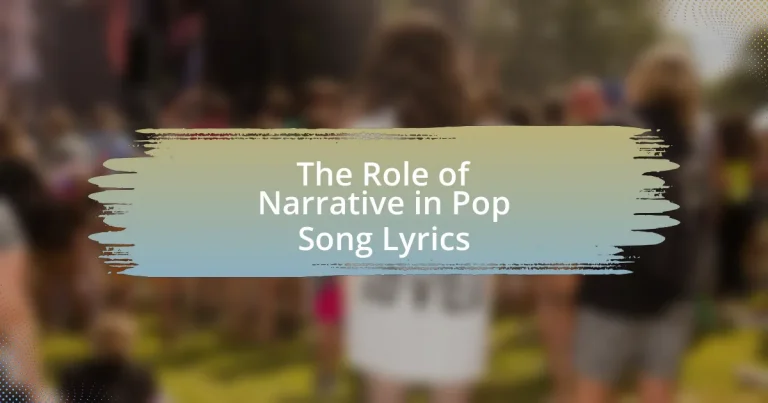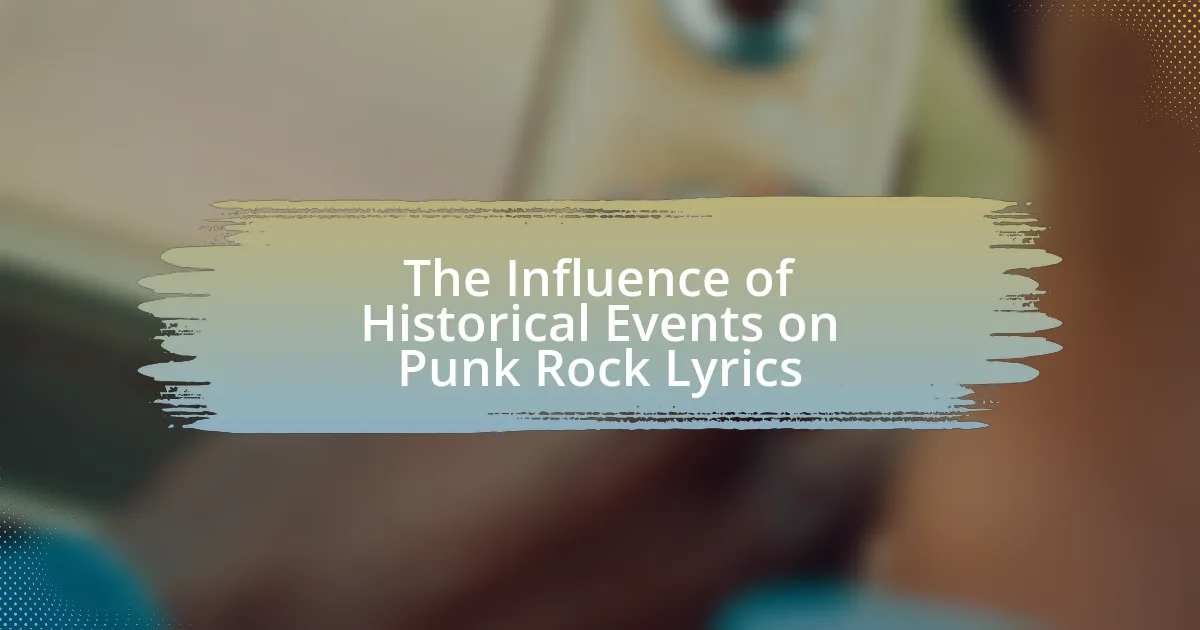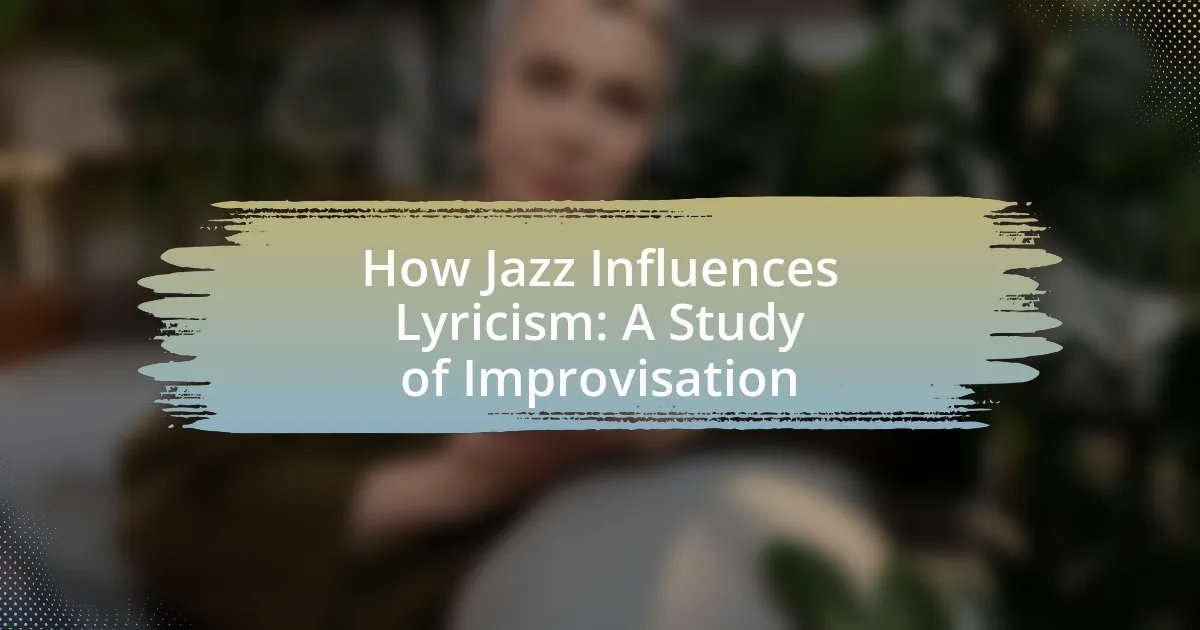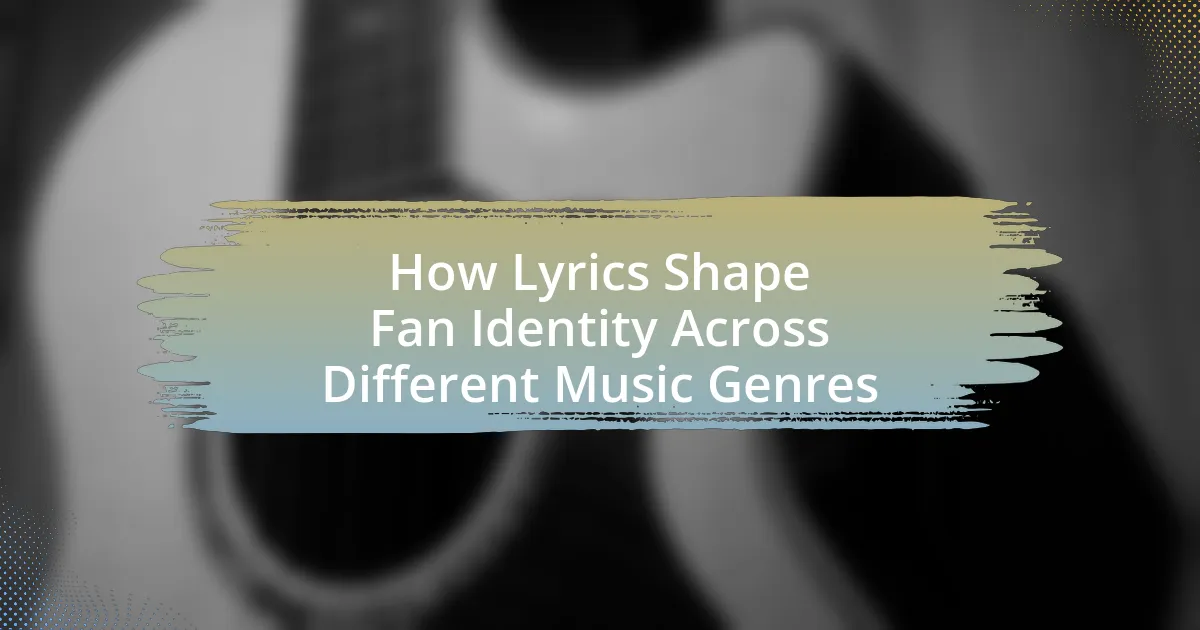The article examines the role of narrative in pop song lyrics, highlighting how storytelling enhances emotional engagement and relatability for listeners. It discusses various storytelling techniques, such as first-person narratives and vivid imagery, which contribute to the emotional impact of songs. Additionally, the article explores how narratives connect with personal experiences, address social issues, and influence audience reception, ultimately emphasizing the importance of narrative structure in creating memorable and impactful pop music. Key themes, character development, and the psychological effects of narratives on listeners are also analyzed, providing a comprehensive understanding of their significance in the genre.
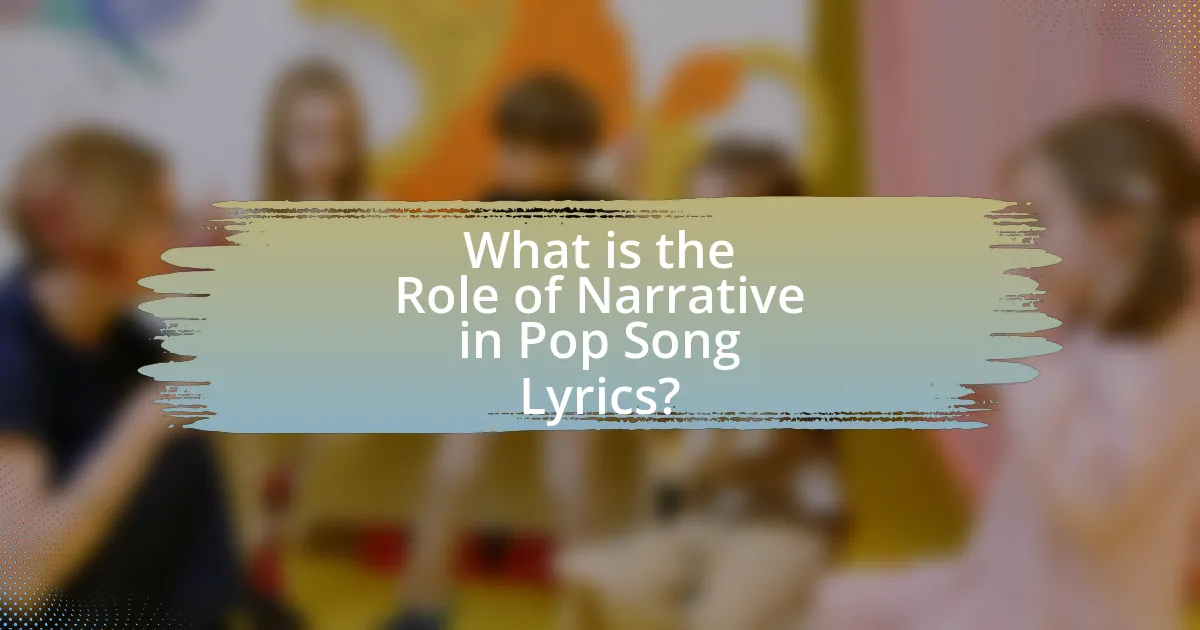
What is the Role of Narrative in Pop Song Lyrics?
The role of narrative in pop song lyrics is to convey stories and emotions that resonate with listeners. Narratives in pop songs often include relatable themes such as love, heartbreak, and personal growth, which help to engage the audience on an emotional level. For instance, songs like Taylor Swift’s “Love Story” and Ed Sheeran’s “Castle on the Hill” utilize storytelling techniques to create vivid imagery and connect with listeners’ experiences. This narrative approach not only enhances the memorability of the song but also fosters a deeper connection between the artist and the audience, making the lyrics more impactful and meaningful.
How does narrative enhance the emotional impact of pop songs?
Narrative enhances the emotional impact of pop songs by providing a structured storyline that listeners can relate to and engage with. This storytelling element allows artists to convey complex emotions and experiences, making the lyrics more relatable and memorable. For instance, songs like Taylor Swift’s “All Too Well” utilize vivid imagery and personal anecdotes to evoke nostalgia and empathy, demonstrating how narrative can deepen emotional resonance. Research indicates that songs with a clear narrative structure are more likely to elicit strong emotional responses, as they create a connection between the listener and the song’s characters and events.
What storytelling techniques are commonly used in pop song lyrics?
Common storytelling techniques used in pop song lyrics include first-person narratives, vivid imagery, and emotional arcs. First-person narratives create a personal connection, allowing listeners to relate to the singer’s experiences. Vivid imagery paints detailed scenes, enhancing the emotional impact and making the story more engaging. Emotional arcs, which involve a progression of feelings throughout the song, help convey a journey or transformation, often resonating with listeners on a deeper level. These techniques are prevalent in successful pop songs, as they effectively draw in audiences and evoke strong emotional responses.
How do narratives in lyrics connect with listeners’ personal experiences?
Narratives in lyrics connect with listeners’ personal experiences by evoking emotions and memories that resonate with their own life stories. When songwriters craft narratives that depict relatable themes such as love, loss, or triumph, listeners often find parallels in their own experiences, creating a sense of connection. Research indicates that music can trigger autobiographical memories, enhancing emotional responses; for instance, a study published in the journal “Psychology of Music” found that lyrics reflecting personal struggles can lead to increased empathy and self-reflection among listeners. This emotional engagement fosters a deeper bond between the listener and the song, making the narrative more impactful and memorable.
Why is narrative important for the structure of pop songs?
Narrative is important for the structure of pop songs because it provides a cohesive storyline that engages listeners emotionally. This engagement is crucial, as studies show that songs with a clear narrative arc tend to resonate more with audiences, leading to increased memorability and relatability. For example, songs like “The Night the Lights Went Out in Georgia” by Vicki Lawrence illustrate a compelling story that captivates listeners, enhancing their connection to the music. Additionally, a well-structured narrative can guide the song’s progression, creating tension and resolution that mirrors the emotional journey of the listener, thereby reinforcing the song’s impact.
What are the common narrative structures found in pop music?
Common narrative structures found in pop music include the verse-chorus format, storytelling arcs, and character-driven narratives. The verse-chorus format typically alternates between verses that develop the story and a catchy chorus that encapsulates the main theme, making it memorable for listeners. Storytelling arcs often follow a clear beginning, middle, and end, allowing artists to convey a complete narrative within a short timeframe. Character-driven narratives focus on specific personas or experiences, often reflecting personal emotions or societal issues, which resonate with audiences. These structures are prevalent in numerous hit songs, demonstrating their effectiveness in engaging listeners and conveying relatable themes.
How does narrative influence the pacing and flow of a song?
Narrative significantly influences the pacing and flow of a song by dictating the structure and emotional trajectory of the lyrics. A well-crafted narrative can create tension and release, guiding the listener through various emotional states, which in turn affects the tempo and rhythm of the music. For instance, songs that tell a story often have varying sections—such as verses, choruses, and bridges—that align with the narrative arc, allowing for dynamic shifts in pacing. Research indicates that songs with a clear narrative structure tend to engage listeners more effectively, as they can anticipate changes in flow that correspond to the unfolding story. This alignment between narrative and musical elements enhances the overall listening experience, making the song more memorable and impactful.
What themes are often explored through narratives in pop lyrics?
Common themes explored through narratives in pop lyrics include love, heartbreak, empowerment, and self-discovery. Love is frequently depicted through stories of romance and relationships, while heartbreak often reflects the emotional pain of lost love. Empowerment narratives highlight personal strength and resilience, often encouraging listeners to overcome challenges. Self-discovery themes focus on personal growth and identity, illustrating the journey of understanding oneself. These themes resonate widely, as evidenced by the popularity of songs that address these universal experiences, making them relatable to diverse audiences.
How do narratives address social issues in pop music?
Narratives in pop music address social issues by weaving personal stories and broader societal themes into lyrics, creating relatable and impactful messages. For instance, songs like “Same Love” by Macklemore and Ryan Lewis tackle LGBTQ+ rights, using storytelling to highlight discrimination and promote acceptance. This narrative approach not only raises awareness but also fosters empathy among listeners, as evidenced by the song’s significant influence on public discourse surrounding marriage equality. Additionally, artists like Billie Eilish address mental health issues in tracks such as “Bellyache,” where the narrative explores guilt and anxiety, resonating with a generation facing similar struggles. These examples illustrate how narratives in pop music serve as a vehicle for social commentary, encouraging dialogue and reflection on pressing societal concerns.
What role does character development play in pop song narratives?
Character development is crucial in pop song narratives as it allows listeners to connect emotionally with the story being told. Through the evolution of characters, songs can convey themes of love, loss, and personal growth, making the narrative relatable and engaging. For instance, in Taylor Swift’s “Love Story,” the character’s journey from uncertainty to resolution illustrates a transformation that resonates with audiences, enhancing the song’s emotional impact. This connection is supported by research indicating that narratives with well-developed characters lead to greater listener engagement and empathy, as seen in studies on storytelling in music psychology.

How do Artists Utilize Narrative in Their Lyrics?
Artists utilize narrative in their lyrics by crafting stories that convey emotions, experiences, and messages, allowing listeners to connect on a personal level. This storytelling approach often includes character development, plot progression, and vivid imagery, which enhance the listener’s engagement and understanding of the song’s themes. For instance, Taylor Swift frequently employs autobiographical elements and detailed scenarios in her lyrics, creating relatable narratives that resonate with her audience. This technique not only captivates listeners but also fosters a deeper emotional response, as evidenced by the widespread popularity of her storytelling songs, such as “Love Story” and “The Story of Us.”
What techniques do songwriters use to craft compelling narratives?
Songwriters use techniques such as storytelling, imagery, and emotional resonance to craft compelling narratives. Storytelling involves creating a clear beginning, middle, and end, allowing listeners to follow a journey or experience. Imagery enhances the narrative by using descriptive language that evokes sensory experiences, making the story more relatable and vivid. Emotional resonance is achieved through the use of personal experiences or universal themes, which connect with listeners on a deeper level. For example, Taylor Swift often employs these techniques in her lyrics, weaving personal anecdotes with relatable emotions, resulting in songs that resonate widely with audiences.
How do metaphors and imagery enhance storytelling in lyrics?
Metaphors and imagery enhance storytelling in lyrics by creating vivid mental pictures and emotional connections that engage listeners. These literary devices allow songwriters to convey complex ideas and feelings succinctly, making the narrative more relatable and impactful. For instance, in Taylor Swift’s “All Too Well,” the use of imagery like “autumn leaves” evokes nostalgia and sets a specific emotional tone, allowing listeners to visualize and feel the story being told. This technique not only enriches the narrative but also deepens the listener’s emotional experience, making the song memorable and resonant.
What role does perspective play in shaping a song’s narrative?
Perspective is crucial in shaping a song’s narrative as it determines the point of view from which the story is told. This choice influences the emotional depth, relatability, and overall impact of the lyrics. For instance, a first-person perspective allows listeners to connect intimately with the narrator’s feelings and experiences, while a third-person perspective can provide a broader context or commentary on the situation. Songs like “I Will Always Love You” by Dolly Parton exemplify how a personal perspective can evoke strong emotions, making the narrative more poignant and engaging for the audience.
How do different genres of pop music approach narrative?
Different genres of pop music approach narrative through distinct thematic elements and storytelling techniques. For instance, country pop often emphasizes personal storytelling and relatable life experiences, as seen in songs like Taylor Swift’s “Love Story,” which narrates a romantic tale. In contrast, synth-pop frequently utilizes abstract and futuristic themes, focusing less on linear storytelling and more on emotional resonance, exemplified by artists like CHVRCHES. Additionally, hip-hop-infused pop often incorporates narrative through spoken word and social commentary, as demonstrated in songs like “Alright” by Kendrick Lamar, which addresses systemic issues while weaving personal anecdotes. Each genre’s unique approach to narrative reflects its cultural context and audience expectations, shaping how stories are conveyed in pop music.
What are the differences in narrative style between mainstream and indie pop?
Mainstream pop typically employs a straightforward, relatable narrative style that focuses on universal themes such as love, heartbreak, and celebration, often using catchy hooks and repetitive structures to enhance memorability. In contrast, indie pop tends to embrace a more experimental and introspective narrative style, often incorporating unique storytelling techniques, abstract imagery, and personal experiences that may not conform to conventional pop tropes. This distinction is evident in the lyrical content, where mainstream pop often prioritizes commercial appeal and accessibility, while indie pop values artistic expression and emotional depth, allowing for a more nuanced exploration of themes.
How does the cultural background of an artist influence their narrative choices?
The cultural background of an artist significantly influences their narrative choices by shaping the themes, symbols, and perspectives they incorporate into their work. Artists often draw from their personal experiences, traditions, and societal contexts, which inform the stories they tell through their lyrics. For instance, an artist from a specific cultural heritage may utilize folklore, language, or historical events relevant to their background, creating a unique narrative that resonates with their community. This is evident in the works of artists like Bob Marley, whose reggae lyrics reflect Jamaican culture and social issues, or Shakira, who blends Latin influences and bilingual lyrics to express her identity. Such cultural elements not only enrich the narrative but also connect with audiences on a deeper level, making the artist’s message more relatable and impactful.
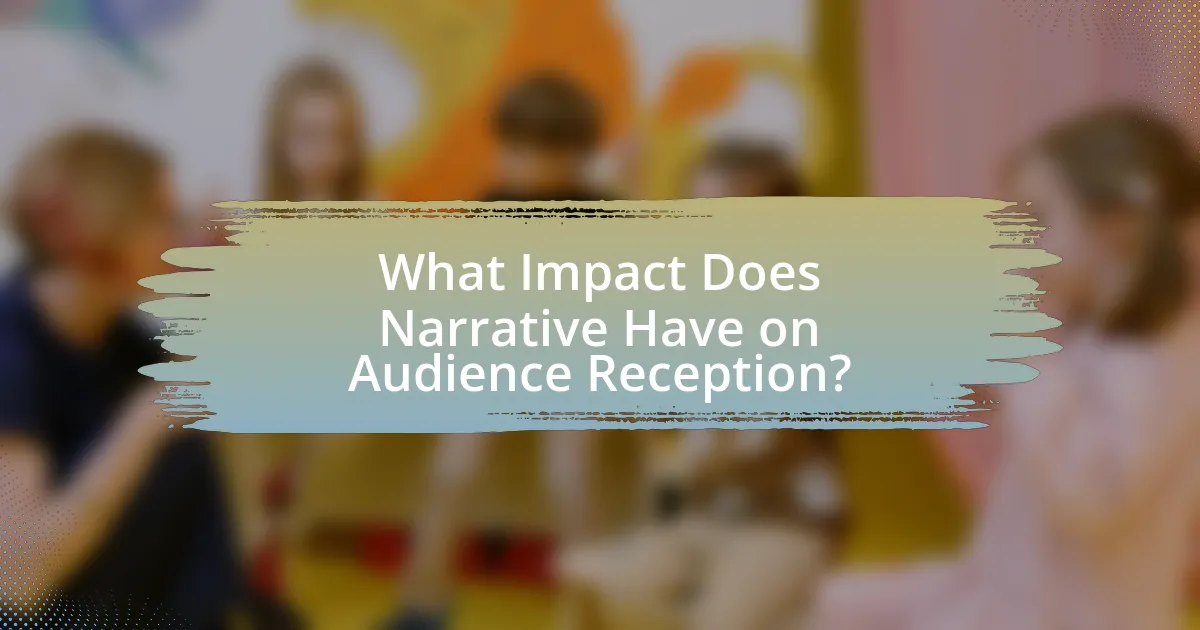
What Impact Does Narrative Have on Audience Reception?
Narrative significantly influences audience reception by shaping emotional engagement and relatability. When a song tells a story, it allows listeners to connect personally with the lyrics, enhancing their emotional response. Research indicates that narratives in music can evoke stronger emotional reactions compared to non-narrative lyrics, as demonstrated in a study published in the Journal of Experimental Psychology, which found that storytelling in songs leads to increased listener empathy and connection. This emotional engagement often results in a more memorable experience, encouraging repeated listening and deeper appreciation of the song.
How do narratives in pop songs affect listener engagement?
Narratives in pop songs significantly enhance listener engagement by creating relatable stories that evoke emotional responses. When listeners connect with the characters and situations depicted in the lyrics, they are more likely to feel invested in the song. Research indicates that songs with strong narratives can lead to increased emotional arousal and memory retention, making the listening experience more impactful. For example, a study published in the Journal of Consumer Research found that narratives in music can enhance emotional engagement, leading to a greater likelihood of repeated listening and sharing among audiences. This connection between narrative and emotional response underscores the importance of storytelling in pop music for fostering deeper listener engagement.
What psychological effects do narratives have on listeners?
Narratives have significant psychological effects on listeners, primarily influencing their emotions, beliefs, and behaviors. Research indicates that narratives can evoke empathy, allowing listeners to connect with characters and situations, which can lead to emotional engagement and a deeper understanding of diverse perspectives. For instance, a study by transportation theory suggests that when individuals become immersed in a narrative, they experience a psychological state that enhances their emotional responses and can alter their attitudes and intentions. This effect is supported by findings from the Journal of Personality and Social Psychology, which demonstrate that narratives can change listeners’ beliefs about social issues by fostering empathy and reducing prejudice.
How do narratives contribute to a song’s memorability?
Narratives significantly enhance a song’s memorability by creating relatable stories that listeners can connect with emotionally. When a song tells a compelling story, it engages the audience’s imagination and fosters a deeper emotional response, making the song more likely to be remembered. Research indicates that songs with clear narratives often have higher recall rates; for instance, a study published in the Journal of Experimental Psychology found that participants remembered songs with narrative structures better than those without. This connection between storytelling and memory retention underscores the importance of narratives in making songs memorable.
What are the common reactions of audiences to narrative-driven pop songs?
Audiences commonly react to narrative-driven pop songs with emotional engagement, relatability, and a sense of connection to the story being told. This engagement often manifests as listeners feeling empathy for the characters or situations depicted in the lyrics, which can lead to personal reflections on their own experiences. Research indicates that songs with strong narratives can evoke specific emotions, such as nostalgia or sadness, enhancing the overall listening experience. For example, a study published in the journal Psychology of Music found that narrative elements in songs significantly increase listeners’ emotional responses, demonstrating the power of storytelling in music.
How do narratives foster a sense of community among listeners?
Narratives foster a sense of community among listeners by creating shared experiences and emotional connections. When listeners engage with a narrative, they often identify with the characters or situations presented, which can evoke empathy and a sense of belonging. This shared emotional journey can lead to collective discussions and bonding over common themes, such as love, struggle, or triumph. Research indicates that storytelling in music, particularly in pop song lyrics, enhances social cohesion by allowing listeners to relate their personal experiences to the narrative, thereby reinforcing communal ties. For example, studies have shown that songs with relatable narratives can lead to increased social interaction among fans, as they share their interpretations and feelings about the music, further solidifying their community.
What role does nostalgia play in the reception of narrative lyrics?
Nostalgia significantly enhances the reception of narrative lyrics by evoking emotional connections and memories in listeners. This emotional resonance often leads to a deeper engagement with the song’s story, as individuals relate personal experiences to the themes presented. Research indicates that nostalgia can increase the enjoyment of music, as seen in a study published in the journal “Psychology of Music,” which found that nostalgic songs elicit stronger emotional responses and greater listener satisfaction. Thus, nostalgia serves as a powerful tool in making narrative lyrics more impactful and memorable for audiences.
What are some best practices for writing narrative-driven pop lyrics?
Best practices for writing narrative-driven pop lyrics include creating a clear storyline, developing relatable characters, and using vivid imagery. A clear storyline helps listeners follow the progression of the song, while relatable characters allow them to connect emotionally with the narrative. Vivid imagery enhances the storytelling by painting a picture in the listener’s mind, making the experience more immersive. For example, Taylor Swift often employs these techniques, weaving personal stories into her lyrics that resonate with a wide audience, demonstrating the effectiveness of narrative in pop music.
How can songwriters effectively balance narrative and melody?
Songwriters can effectively balance narrative and melody by ensuring that the melody enhances the emotional impact of the narrative. This involves crafting a melody that complements the story being told, using musical elements such as dynamics, rhythm, and phrasing to reflect the narrative’s mood and progression. For instance, a rising melody can signify hope or excitement, while a descending melody may convey sadness or reflection. Research indicates that melodies that align with lyrical themes can increase listener engagement and emotional response, as demonstrated in studies on music psychology. By integrating these elements thoughtfully, songwriters can create a cohesive and compelling experience that resonates with their audience.
What tips can help in creating relatable characters in song lyrics?
To create relatable characters in song lyrics, focus on incorporating universal emotions and experiences that resonate with listeners. By using specific details and vivid imagery, songwriters can evoke feelings that listeners may have encountered in their own lives. For instance, referencing common life events such as heartbreak, joy, or personal growth allows listeners to connect with the character’s journey. Additionally, employing authentic dialogue and inner thoughts can enhance relatability, as it mirrors real-life conversations and emotions. Research indicates that songs with relatable themes often achieve higher listener engagement, demonstrating the effectiveness of this approach in songwriting.
